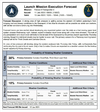I always wonder how the heavy payload which has to be tightly coupled to the docking adapter, gets released so effortlessly? It can't be bolted.
Typically restraint and release solutions fall under a few categories:
1. Most satellites use some kind of circular clamp band that compresses a circular interface on the satellite against a circular interface on the rocket. Traditionally this has been a
v-band, where tension around the band is important, though folks like
planetary use sort of a camming configuration that is actually a bit more forgiving during the installation and release (that concept doesn't scale up to things like big GEOs). Tension in v-bands is usually released via cutting a rod/bolt (a small charge is used to slam an anvil against a rod), or what's called a 'spool' or
'split spool' device, which is basically a way to release a similar amount of load without explosives. Explosives are SUPER reliable and have been used for decades all over the space industry, but they also require a higher level of safety during handling...the natural progression of everything is to non-pyro releasing via spools.
2. Most 'big' constellation satellites (like
iridium) plus some big Boeing sats (noted because they're the only big sat to not use a clamp band) will use ~4 spool devices to release from the dispenser (or upper stage, for the B-sat).
3. Most "smallsats"--like the non-cubesat sats on Tansporter--will use a 15" or 24" ring, either a v-band or a planetary lightband.
4. Cubesats are housed in something that's
basically like a mailbox--there's a number of them on Transporter if you look around. Most of the dispensers you see are 3u, which means a 30cm x 10cm x 10cm sat.
For all of these, and to varying degrees, the satellites are compressing springs that, when the release device is...uhh...released, the springs push away the satellite from the rocket. In some cases the spring configuration can be asymmetric, either in quantity (around a circle), in spring rate, or both. What this does is purposely eject a satellite into a tumble. That's actually a good thing, as it means there's basically zero chance a satellite's T&C antennas will fall in a null, so there's zero chance you won't be able to communicate with the sat.
5. We've talked about Starlink elsewhere, but their solution is to-date unique. The satellites are all stacked and have features that sort of nest into one another (kinda like stacking legos, but without the positive locking) and then the whole stack is compressed with tensioning rods on the outside of the stack. For deployment, tension in the rods is first released by camming gizmos at the bottom of the stack, then a small restraint mechanism releases the rods from the top of the stack. During deployment on orbit the whole thing is in a flat spin, and as soon as the rods are released the satellites naturally get flung away from the upper stage, since there's nothing else holding them in place. Because of the whole angular momentum thing the top satellites get flung a little more than the bottom ones, and that's why you see the deck-of-cards spread out at the top more than the bottom.
In all cases there's an energy equation going on and that need to be managed, but things like springs or spin rates are carefully calculated such that there's not a huge step function/impulse when The Whole Thing breaks its energy into some larger number of smaller things (like a GEO separating from an upper stage, or 60 starlings separating from an upper stage)...basically that's why any satellite release seems gentle and effortless.
Also how is it not falling over and hitting the fairings when the rocket tilts over just in less than 30 seconds after launch?
The same reason it doesn't fall over when the fairing+payload is rotated vertical in the integration facility, and the same reason it doesn't fall over all the way through rollout (which is all with the payload in a horizontal orientation). A payload (whether a big GEO, a starlink stack, or this transporter stack) is a more or less rigid structural entity that can easily support itself in a cantilevered manner. In fact, at least from a first order perspective, most payloads need to be able to manage ~2g lateral loads during launch, and that's also the case for Falcon 9. (
See figure 4-1). When on the ground and in a horizontal/cantilevered position gravity is acting on the payload is in the same coordinate system as the launch lateral loads (and of course is doing so with 1g), so the 2g flight environment basically envelopes that ground use case with plenty of margin for things like handling loads. Any gravity component in flight (basically, any time the rocket isn't going exactly vertical) necessarily resolves to something less than 1g in the lateral direction (tangent to the rocket's flight vector) is of course also enveloped by this 2g requirement.

 spaceflight.com
spaceflight.com




